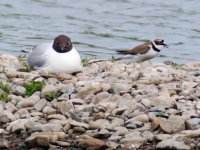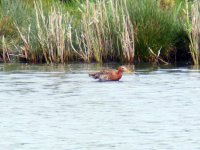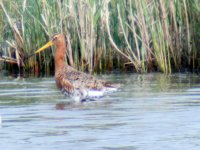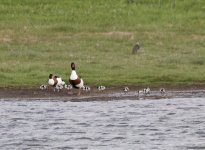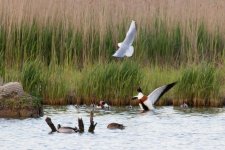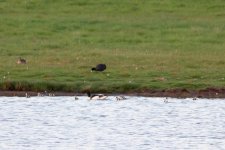upstarts1979
Well-known member
We removed the cover from the tern raft, but unfortunately a pair of BHG took occupancy. Hopefully the terns will soon evict them. The only migrant today at the Moors was a common sandpiper and a late snipe flushed from the boat launch site. A largish grass snake was roosting underneath the boat.
Thanks to the 3 Bob's O,P&R and Tony B for sorting it.
MOORS:
GCG 3 ads but only one chick. Possible the cold wet conditions of yesterday put pay to the other 2. Little grebe only 2 seen presumably several birds are sitting. Shoveler pr + male commuting between here and the North moors pool, where 12 tufted were also seen. Tufted 40ish. Oystercatcher 4 + 1 chick, lapwing 2 a pair almost certainly breeding. snipe, common sand, Med gull 2nd summer, BHG c100 nests, herring gull 2nd summer killed a BHG chick, common tern 8, Buzzard 2, collared dove 2, kingfisher, swift c80, cettis w 2, whitethroat, reed w 5 east side, sedge w,
FLASHES:
We have lost 2 chicks from yesterday almost certainly as a result of the weather. A 9th brood of 2 were feeding off the grassy knoll north. This meant that there are 7 broods within a 40 metre radius of the hide. All feeding in shallow channels and ditches, this will be an important factor when the question of 'lower water levels' crops up again. Several broods of mallard included a brood of 13, which were given short shrift by the avocets when they ventured into their chicks territory. Strange behaviour but understandable as the ducklings must consume vast amounts of invertebrates. The BHG chicks seem to be free of last years slaughter by the LBBG hordes, although this might be a result of the avocets breeding early, as they don't tolerate the gulls.
Species count Flashes:
Shoveler 3 (pr + male), gadwall 2 males, shelduck 5, tufted 16, coot 18+, Avocet 28 - 30 ads and 23 chicks, lapwing 12, LRP 4, oystercatcher 2, Black tailed godwit, common sand, BHG 150 nests, stock dove 5, raven 2 well grown chicks in the transmitter nest, whitethroat, linnet 8,
Sailing pool: GCG 4, lesser whitethroat
Thanks to the 3 Bob's O,P&R and Tony B for sorting it.
MOORS:
GCG 3 ads but only one chick. Possible the cold wet conditions of yesterday put pay to the other 2. Little grebe only 2 seen presumably several birds are sitting. Shoveler pr + male commuting between here and the North moors pool, where 12 tufted were also seen. Tufted 40ish. Oystercatcher 4 + 1 chick, lapwing 2 a pair almost certainly breeding. snipe, common sand, Med gull 2nd summer, BHG c100 nests, herring gull 2nd summer killed a BHG chick, common tern 8, Buzzard 2, collared dove 2, kingfisher, swift c80, cettis w 2, whitethroat, reed w 5 east side, sedge w,
FLASHES:
We have lost 2 chicks from yesterday almost certainly as a result of the weather. A 9th brood of 2 were feeding off the grassy knoll north. This meant that there are 7 broods within a 40 metre radius of the hide. All feeding in shallow channels and ditches, this will be an important factor when the question of 'lower water levels' crops up again. Several broods of mallard included a brood of 13, which were given short shrift by the avocets when they ventured into their chicks territory. Strange behaviour but understandable as the ducklings must consume vast amounts of invertebrates. The BHG chicks seem to be free of last years slaughter by the LBBG hordes, although this might be a result of the avocets breeding early, as they don't tolerate the gulls.
Species count Flashes:
Shoveler 3 (pr + male), gadwall 2 males, shelduck 5, tufted 16, coot 18+, Avocet 28 - 30 ads and 23 chicks, lapwing 12, LRP 4, oystercatcher 2, Black tailed godwit, common sand, BHG 150 nests, stock dove 5, raven 2 well grown chicks in the transmitter nest, whitethroat, linnet 8,
Sailing pool: GCG 4, lesser whitethroat
Last edited:




